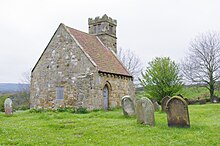The Old Church of St Andrew is a redundant grade II* listed Anglican church in the village of Upleatham, Redcar and Cleveland, England. Parts of the church date back to the 12th century, and it was replaced as a working church by the newer Church of St Andrew, which is located closer to the village, the old church being outside of Upleatham. Although no longer used for services, the church is noted as being one of the smallest in England.
| Old Church of St Andrew | |
|---|---|
 Old Church of St Andrew | |
 | |
| 54°33′54″N 1°00′58″W / 54.565°N 1.016°W | |
| Location | Upleatham, Redcar and Cleveland |
| Country | England |
| Denomination | Anglican |
Listed Building – Grade II* | |
| Designated | 25 April 1954 |
| Reference no. | 1139759 |
History
editThe Old Church of St Andrew is noted as being one of the smallest churches in England, due to its size of just 20 feet (6 m) by 13 feet (4 m)[1] (only one church in England is smaller - Bremilham Church in Wiltshire).[2] The church was historically bigger than the size it is today, with historians believing that in 1684, when the tower was added, the south side of the church was removed.[3] The current size of the church only allows 30 worshippers inside.[4]
The church is thought to have existed since at least the 12th century, and the first mention of the church at Upleatham is when it was given to the canon and priors of Gisborough Priory, who had parochial rights over the area.[5] The Brus family donated most of their land and the churches to Gisborough Priory c. 1119, around the time of the priory's founding.[6]
Excavations on the site in 1911 unearthed a ninth century Anglo-Danish cross, which suggests the village existed pre-dates the Domesday survey.[7] In 1974, further archaeological digs revealed some fragments of a cross that dates back to the 10th century.[8] The church is 0.5-mile (0.8 km) outside of the village to the east along the B1268 road.[9][10] It is thought that the village was moved to its present location in the 16th–17th century, but the reasons for the re-location, and leaving the church alone, are unknown.[11]
All that remains of the church is the west end of the nave, which is Norman in architecture, an embattled tower on the west side, and fragments of the ruined church on the eastern side.[12][13] Archaeological investigations of the church's footprint and the ruins, have lead to an estimation that the original nave was 36 feet (11 m) long by 18 feet 9 inches (5.72 m) wide.[3] The east wall is a later addition to the fabric of the church, believed to have been erected when the rest of the church was removed in 1822.[1] In the eastern part of the churchyard is a low wall, part of the original church and the location of the Lowther Vault.[14]
The church is within the boundary of the Upleatham conservation area, and was grade II* listed in 1954.[15][16] It is maintained by the National Churches Trust.[17] From the 1830s, services were moved to the newer Ignatius Bonomi designed St Andrew's Church in the same village, however, this also ceased being an active church in 1989, and has been converted into a private home.[18][8][19][20] After being supplanted by the newer church, the Old Church of St Andrew became a mortuary chapel.[21]
References
edit- ^ a b Annis 1991, p. 5.
- ^ "Cowage Bremilham Church". nationalchurchestrust.org. Retrieved 19 February 2024.
- ^ a b Page 1968, p. 413.
- ^ Taylor, Richard (2004). How to read a church: an illustrated guide to images, symbols and meanings in churches and cathedrals. London: Rider. p. 29. ISBN 9781844132386.
- ^ Ord, John Walker (1846). The history and antiquities of Cleveland : comprising the wapentake of East and West Langbargh [sic], North Riding, County York. London: Simpkin and Marshall. p. 349. OCLC 1048899800.
- ^ Blakely, Ruth Margaret (2005). The Brus family in England and Scotland, 1100-1295. Woodbridge: Boydell press. p. 169. ISBN 1-84383-152-X.
- ^ UCAA 2011, p. 3.
- ^ a b Lang, James (2001). Corpus of Anglo-Saxon Stone Sculpture, Volume VI: Northern Yorkshire. Oxford: Oxford University Press. p. 215. ISBN 9780197262566.
- ^ UCAA 2011, p. 11.
- ^ Knight, Shirley (1976). "St Andrew's Old Church, Upleatham". In Addeyman, Peter; Morris, Richard (eds.). The archaeological study of churches. London: The Council for British Archaeology. p. 40. ISBN 0-900312-35-1.
- ^ UCAA 2011, p. 4.
- ^ Page 1968, p. 412.
- ^ Pevsner, Nikolaus (2002) [1966]. Yorkshire, the North Riding. London: Yale University Press. p. 377. ISBN 0-300-09665-8.
- ^ Annis 1991, p. 7.
- ^ UCAA 2011, p. 25.
- ^ Historic England. "Old Church of St Andrew (Grade II*) (1139759)". National Heritage List for England. Retrieved 15 February 2024.
- ^ "Upleatham St Andrew Old Church". nationalchurchestrust.org. Retrieved 15 February 2024.
- ^ UCAA 2011, p. 5.
- ^ Tims, Anna (28 October 2016). "A converted church in North Yorkshire – in pictures". The Guardian. Retrieved 15 February 2024.
- ^ Webster, Christopher; Brandwood, Geoff (2022). Late-Georgian churches: Anglican architecture, patronage and churchgoing in England, 1790-1840. London: John Hudson Publishing. p. 289. ISBN 978-1-7398229-0-3.
- ^ Cook, Hugh (30 August 1909). "Ancient history of Upleatham". The North Star. No. 8, 889. p. 3. OCLC 751720286.
Sources
edit- Page, William, ed. (1968). The Victoria history of the county of York, North Riding volume two. London: Dawsons of Pall Mall for the University of London Institute of Historical Research. ISBN 0712903100.
- Upleatham Conservation Area Appraisal (PDF). redcar-cleveland.gov.uk (Report). Redcar: Redcar & Cleveland Borough Council. 2011. Retrieved 15 February 2024.
- Annis, Richard (1991). "Saint Andrew's Old Church, Upleatham". Cleveland History (61). Cleveland and Teesside local history society. ISSN 0590-8434.